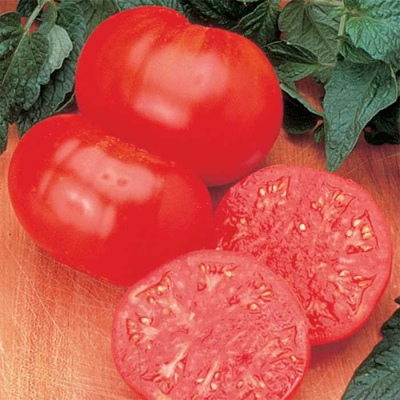
- Authors: Ognev V.V., Klimenko N.N., Kostenko A.N. (LLC "Agrofirma Poisk")
- Year of approval: 2009
- Category: grade
- Growth type: indeterminate
- Appointment: universal
- Ripening period: mid-early
- Ripening time, days: 110-120
- Growing conditions: for open ground, for film greenhouses, for greenhouses
- Bush size: tall
- Bush height, cm: 160-180
Beefsteak is a tomato variety bred by Agrofirma Poisk LLC. In 2009 this variety was approved for use. It immediately became clear that, due to some features, it was not suitable for industrial cultivation, but private summer residents immediately fell in love with this tomato. Let's figure out how he won the hearts of gardeners.
Description of the variety
The bush is tall, its height reaches 160-180 cm. The leaves are light green in color, of medium size.
The main qualities of the fruit
The tomatoes are large, each weighing 200-280 g. An unripe specimen has a green skin, ripe tomatoes are red. The shape is flat, slightly ribbed. The inflorescence is simple, the stalk is articulated. The skin is very thin, and therefore these tomatoes have a very short shelf life - no more than 4-5 days in the refrigerator. That is why the Beefsteak variety is not suitable for growing on an industrial scale.
Taste characteristics
The flesh of the fruit is sweet, fleshy, there is little liquid in it, therefore, when cutting, they do not drain out of juice. This variety is highly regarded in the culinary world. Juices, tomato paste, sauces, adjika are made from tomatoes, but their pronounced taste is best felt in a salad with fresh green leaves.
Ripening and fruiting
Beefsteak is a medium-early ripening variety. The taste of the first tomatoes can be appreciated in 110-120 days. Harvesting usually falls on July 20 - August 30.
Yield
This is a variety with a high degree of yield, subject to all the rules of agricultural technology, you can get a harvest of 11 kg / sq. m.
The timing of planting seedlings and planting in the ground
Sowing for seedlings begins on March 10-20. The seeds are planted in grooves at a distance of 3 cm from each other, they are buried by a maximum of 1.5 cm. After sowing, the soil is sprayed with water and covered with foil. High-quality seedlings are considered at the age of 56-60 days, that is, a transplant to a summer cottage is carried out on May 10-20.

Growing tomato seedlings is an extremely important process, because it largely depends on whether the gardener will be able to harvest at all. All aspects must be taken into account, from seedbed preparation to planting in the ground.
Landing scheme
Growing tomatoes Beefsteak is allowed in the open field, in greenhouses and film greenhouses. When transplanting seedlings, adhere to the 60x40 cm scheme, the planting density should be 3 plants per m2.

Growing and care
At the stage of growing seedlings, install phytolamps if there is not enough sun for young shoots. Monitor the moisture content of the soil, but avoid waterlogging. Iodine can be used as a fertilizer. When 3-4 leaves appear, dive the seedlings.
When the time comes for transplanting, prepare humus, wood ash, diluted in boiling water, and add the resulting mixture to the planting holes. Do not be afraid of the transplanting process, the seedlings of this variety are quite strong, and their root system only strengthens in the new soil. Water the bed after planting.
With further care, do not be zealous when watering, this variety does not tolerate waterlogging. Additional food can be potassium and phosphorus or a solution of wood ash. Top dressing is applied after watering.
The bushes are tall, and therefore they constantly need to be tied up. To prevent brittleness of the brushes, they should also be gartered. To ensure good circulation and increase yields, it is necessary to remove excess foliage and stepchildren throughout the season.




A plant needs different micronutrients at each stage of growth. All fertilizers can be divided into two groups: mineral and organic. Folk remedies are often used: iodine, yeast, bird droppings, eggshells.
It is important to observe the rate and period of feeding. This also applies to folk remedies and organic fertilizers.
Disease and pest resistance
The Beefsteak variety is almost not affected by Alternaria, cladosporium, tobacco mosaic virus, it is not prone to cracking fruits either, but late blight can threaten the health of the plant, especially in cold summer. For prevention, it is recommended to introduce biological products "Glyokladin" or "Alirin" at the planting stage, and periodically irrigate the culture with "Fitosporin".
If the defeat could not be avoided, then the damaged leaves should be removed, and the culture should be treated with copper sulfate or other chemical agent. In case of severe damage, the diseased bush is recommended to be destroyed outside the site.



























































































